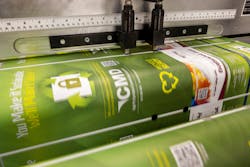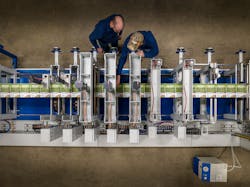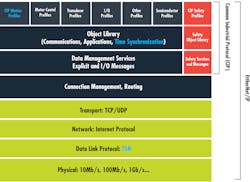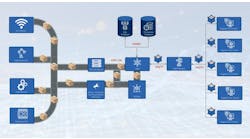Unlocking enhanced motion control: How deterministic networks and time-sensitive networking are changing industrial automation
A Control Design reader writes: How has the acceptance of industrial networks, especially deterministic networks such as EtherCAT, improved motion control?
Answers
EtherCAT advantages from its creator
EtherCAT has been redefining what’s possible in motion control since the industrial Ethernet system was released in 2003. It’s a high-speed, high-bandwidth, extremely deterministic fieldbus for every aspect of automation—even safe motion functionality. All of this makes it ideal for all things motor- and drive-related, from the most basic precision time protocol (PTP) systems to extremely advanced applications with hundreds of axes, robotics and mechatronics. Because we invented EtherCAT, we’ve developed our servo, stepper and mechatronics technologies to fully harness the strengths of the protocol.
I could go on and on about how EtherCAT improves motion control. The functional principle of EtherCAT alone—processing on the fly, distributed clocks, free selection of topology—makes it an ideal motion bus. But I’ll work to highlight advantages in three main areas: design, commissioning and operation.
First, design: EtherCAT is an open protocol, and some of the biggest names in servo and stepper technology manufacture EtherCAT devices. The same goes for robot vendors like Denso, Stäubli and Kuka. Finding the perfect components and systems to fit your application is incredibly simple.
But one component you won’t have to worry about is managed switches; EtherCAT is a switchless network. EtherCAT devices don’t even require IP addresses. This simplifies installation, streamlines architectures, cuts costs, reduces communication delays, which are critical for high-performance motion control, and provides free selection of wiring topology.
How much time do you spend calculating network performance? Stop. Invest that time instead in creating new solutions without limits.
But EtherCAT is also incredibly flexible if you need to incorporate other networks. It can easily connect with other fieldbuses when new equipment is installed in brownfield applications, for example. One EtherCAT network can transmit data from devices with a legacy bus like serial real-time communication system (SeRCoS), CANopen, DeviceNet or Profibus, and it can connect with other industrial Ethernet systems like EtherNet/IP and Profinet.
Next, let’s talk commissioning. Unlike those other protocols, one EtherCAT network can connect up to 65,535 nodes, without any special hardware requirements. You can imagine these systems are sometimes spread out, so point-to-point commissioning would be extremely time-consuming. Fortunately, it’s not necessary. EtherCAT optimizes commissioning by passing data through a state machine. The state machine allows the configuration to be loaded in stages. You can configure drives over the network via the main controller without disrupting any other devices. It’s essentially plug and play.
Even hot-connect capability is perfectly fine while the system is running. The state machine checks the drive parameters, makes sure everything is connected correctly and then ensures the distributed clocks are synchronized.
In this discussion, distributed clocks are a critical feature. This technology enables the EtherCAT protocol to synchronize the time in all local devices within a very narrow tolerance range. EtherCAT devices, from I/O terminals to servo drives, support distributed clock functionality. That means each device on a network contains an internal clock that operates at startup, keeping each axis perfectly in sync with the rest.
Finally, in operation, setpoint generation or path profiles are all deterministically transmitted to the drive. And that’s not just one axis, but all of them.
This deterministic data communication enables extremely fast cycle times. When I say fast, I mean it. One example is the Kinetic Rain moving sculpture at Changi Airport in Singapore, which has 1,200 axes with a mere 1-millisecond cycle time; or there’s the Giant Magellan Telescope in Chile's Atacama Desert, which has 3,000 axes on one EtherCAT network.
A little closer to home, we’ve worked with machine builders, system integrators and end users across all industries who discovered EtherCAT’s competitive advantages in operation.
Unlike drive-based solutions on other networks that have difficulty adapting, the EtherCAT solution’s setpoint generation optimizes path control with smooth adaptation. This is especially true when it comes to functions like camming or logarithmic path profiles.
Another example is ensuring that one axis doesn’t cheat ahead of another in a gantry; being able to command them cyclically in the controller is a huge benefit.
Can other fieldbus protocols deliver this performance? Sometimes. But as you see with Profinet isochronous real-time (IRT), it often needs to add hardware accessories to speed up communication and synchronization for advanced, multi-axis systems. This increases costs and commissioning headaches. Not so with EtherCAT.
The engineers at CMD in Appleton, Wisconsin, noticed these advantages when redesigning their 760-SUP stand-up pouch system. In addition to optimizing a dozen servo axes, the pouch machine had a gusset punch in its continuous-motion section upstream. To synchronize this punch with the continuous material flow using a previous vendor’s technology, they needed all sorts of special networking equipment.
With EtherCAT, it just worked (Figure 1). Lead engineer at CMD, Jason Plutz, said it best: This EtherCAT-based solution was “less expensive in our application, but the technology was also a major leap ahead. We made even bigger advances than we had hoped (Figure 2).”
Matt Prellwitz / drive technology product manager/ Beckhoff Automation
One-stop-shop for all your business
To put it simply, the acceptance of industrial networks like EtherCAT has facilitated the motion-control process moving more into areas that any operator or any stakeholder wants to be in. Those key areas are improved time and space, simplicity or ease of use, and interoperability and conformity.
While I will use EtherCAT to serve as an example of improving motion control through its use, first think of motion control in the following way before EtherCAT. Imagine you have multiple pieces of business to conduct at the state building. You go in and start in one room, and the associate sends you to another room where you have tasks to complete, followed by another room with additional requirements. You eventually complete this business, not looking forward to this again.
Fast forward, now the EtherCAT office opens up and you go in. In this office, the associate provides you with one form that allows input of all your business. This form then allows for the transport of all your business to the appropriate departments. That is industrial networks like EtherCAT. It allows for freeing up of space for devices like central processing units (CPUs), which means faster and cleaner operations.
It creates a simple environment. It is not convoluted, which allows for seamless operations. It permits multiple device additions and exchanges that follow a certain standard. This enables the installation of new devices that will not be subject to multiple protocol requirements and limitations.
Overall, it moves motion control in the direction of creating less of a headache. Who doesn’t want things to be timesaving, simple to do and easily added or removed? You tell me, but I think I know the answer.
Patrick Teagues / product development analyst / Misumi USA
A case for EtherNet/IP and the significance of TSN
Broad market acceptance of industrial Ethernet has improved motion control by allowing for the additional convenience, lower cost and improved diagnostics made possible by using one integrated Ethernet network for different tasks including motion and safety. The additional diagnostics data in particular will grow in importance as machine learning (ML) and artificial intelligence (AI) are applied to more industrial use cases in the future.
While many industrial Ethernet networks were introduced in the early 2000s, including EtherNet/IP, Profinet and EtherCAT, it took until 2017 for industrial Ethernet to overtake fieldbus in new installations. Each industrial Ethernet network approach adds determinism to Ethernet in different ways, which provides the market with multiple choices to fit differing user preferences and application needs.
One of the leading industrial networks, EtherNet/IP, enables precise motion control today via the common industrial protocol (CIP) Motion extension. CIP Motion relies upon the Institute of Electrical and Electronics Engineers (IEEE) 1588 standard and CIP Sync to enable precision clock synchronization.
CIP Motion is unique, in that it removes the requirement for strict determinism from the network infrastructure and entrusts the end devices with the timing information necessary to handle the real-time control needs of the application. Clock synchronization of better than 200 ns can be readily achieved, meeting the needs of the most demanding motion-control applications.
Because the clocks in the end devices are tightly synchronized and information in the message is time-stamped, a small amount of jitter in receipt time of the message is unimportant. EtherNet/IP with CIP Motion can thus deliver the high-performance, deterministic control required for closed loop drive operation, using standard, unmodified Ethernet.
An important consideration for the future of industrial Ethernet determinism is the impact of increased bandwidth. Adoption of Gigabit and faster cabling and devices combined with separate network zones and conduits with vertically layered switches for both security and safety purposes can significantly lessen the need for time-sensitive solutions in some applications.
An additional future option to provide bounded latency and jitter in industrial networks, especially for 100-Mbit/s networks, will be enabled by the International Electrotechnical Commission (IEC)/IEEE 60802 Time Sensitive Networking (TSN) Profile for Industrial Automation standard. 60802 TSN will allow the highest priority traffic, such as motion, safety and I/O, while allowing less critical traffic such as routine diagnostics to wait until additional bandwidth is available. 60802 TSN can significantly reduce the amount of jitter, latency and lost packets due to messages exceeding the available bandwidth.
60802 TSN is able to prioritize critical traffic on an overloaded network via synchronized clocks across the network, critical traffic scheduling, traffic shaping based on relative priority and frame preemption based on packet size. Frame preemption is one of the simplest and most effective methods that 60802 TSN will be able to employ to protect high-priority traffic across an industrial Ethernet network.
60802 TSN can also take advantage of frame replication and elimination for reliability using virtual paths and ingress policing to identify and remove malicious or misbehaving devices from the network.
EtherNet/IP will be able to adapt CIP Motion to 60802 TSN by aligning the network with the motion-control planner using a common notion of time. Once CIP Motion and 60802 are aligned, network transport can be facilitated using scheduling as necessary to meet the needs of the network and coexist fairly with existing traffic (Figure 3). EtherNet/IP specifications are anticipated to have optional extensions enabling IEC/IEEE 60802 TSN compatible products after the IEC/IEEE 60802 TSN specification is released.
It’s important to note that a collaboration between the Avnu Alliance, CC-Link Partner Association, ODVA, OPC Foundation and Profibus and Profinet International will result a single conformance test plan for the IEEE/IEC 60802 Time Sensitive Networking (TSN) Profile for Industrial Automation. This cooperative effort provides end users with confidence that 60802 TSN conformant devices from different manufacturers that support different industrial Ethernet protocols can coexist reliably at the TSN level on shared networks, assuming the usage of a consistent hardware platform.
Steve Fales / marketing director / ODVA
Networking standards increase benefits for industry
Adopting Ethernet has enabled motion control to take advantage of common cabling and connections, as well as increased bandwidth supplied by standard networking technologies, reducing the cost and improving performance of the network for motion control.
EtherCAT and other motion applications and those relying upon them have seen the benefits. The various motion-control applications are at various stages of adopting standards-based, non-proprietary networking models, with more benefits as they adopt more standard models.
The standard networking world is also advancing its time synchronization, resiliency and deterministic networking capabilities even further, as displayed in the IEEE’s TSN enhancements, the joint IEEE/IEC 60802 on adopting these enhancements leading to the OPC Foundation’s work on new motion-control communication standards using fully standardized networking capabilities.
Bringing motion-control applications on to evermore standard networks with evermore capabilities will enable the full value of Industry 4.0 and digitization to be realized by these applications.
Paul Didier / solution architect manager / Cisco
Networks with determinism bring super speed
I always get excited when I think about how much motion control has changed and is still changing. There have been so many advances since the introduction of fieldbuses like Ethernet for control automation technology (EtherCAT) in 2003 and Process Field Network (Profitnet) in 2000. The best way to understand the reasons for their adoption is to look at what they bring to the automation world.
Real-time communication is a strong advantage. You want data transmission to be fast and synchronous. When it comes to complex motion-control applications, EtherCAT is known for its real-time capabilities. It can transmit data at extremely high speeds while maintaining precise synchronization, which can allow for improved motion-control performance. This is not unique to EtherCAT, but it is an important feature of deterministic communication.
Lower latency is a major advantage of industrial networks. Deterministic networks, such as EtherCAT and Profinet, significantly reduce communication and processing latencies. This reduction in latency leads to faster response times in motion-control systems, resulting in improved accuracy and precision when controlling motion-related tasks.
In my opinion, synchronization is one of the most important advantages of deterministic networks like EtherCAT and Profinet. In motion control, multiple axes often need to be synchronized to work together seamlessly. EtherCAT, for example, features distributed clock synchronization, which allows devices to synchronize across the network. This synchronization enables smooth, coordinated motion along multiple axes, which also results in higher accuracy.
With the requirement to integrate multiple processes into one system, deterministic networks also provide flexibility and scalability for the network topology. EtherCAT and Profinet support various communication configurations, such as daisy-chain, which reduces installation time.
Finally, deterministic networks offer solid diagnostic capabilities for monitoring and troubleshooting. In the era of predictive maintenance, these features are more important than ever. They are able to detect potential issues early and minimize downtime—resulting in higher overall system reliability.
In summary, there are many different fieldbuses on the market that have strengths and weaknesses. The power that networks with determinism bring to motion-control applications is superior speed, which is the real reason for the shift to linear motion control.
Perry Hudson / market manager, packaging / Pepperl+Fuchs
Sending data between IT and OT
In the early stages of motion control, most of the control was accomplished with analog and digital signals. As implementations grew and machines continued to add axis count, the amount of wiring and relay logic became unbearable to handle.
This, along with the prevalence of programmable logic controllers (PLCs), made the transition to a communications bus for drives and other field devices a prominent staple in industrial plants by the new millennium. With the installation of Ethernet networks in our homes and offices, it was only natural this technology would find its way to the plant floor.
These Ethernet protocols are built upon the success of fieldbus protocols with the added vigor of speed, determinism, network switch technology and a wide range of other functions to further innovate the industrial plant floor.
In the past decade, capitalizing on being able to receive and send data between the information-technology (IT) and operational-technology (OT) domains has opened up completely new realms of industrial efficiencies, including operational insight, uptime and now artificial intelligence (AI)-led innovations.
Craig Nelson / Sinamics, drives product manager / Siemens Industry
Industrial network acceptance
The acceptance of industrial networks, particularly EtherCAT, as a deterministic network, is really growing our abilities for industrial motion control. Going back to 2003 with the onset of EtherCAT, there has been a very steady increase in its use and capability, as well as practicality in automation.
The ability to process a thousand I/O points in microseconds is a huge advantage in manufacturing, especially when talking about motion control. Devices such as drives depend on speed and accuracy, something that EtherCAT can excel at specifically. With data speeds as high as 100 Mbit/s and improving, many manufacturers of drives have adopted EtherCAT as their number-one choice for industrial networks.
Eric J. Halvorson / partnership marketing manager II—strategic programs for automation and control / DigiKey
Ethernet offers scalability and convergence
Ethernet-based networks offer scalability, in terms of bandwidth and network size, that is relatively easy to wire but not available in traditional fieldbuses. More importantly, Ethernet technologies bring the possibility of convergence of various functions, including motion, safety and planning. Convergence, in turn, offers the ubiquitous data access that is a cornerstone for the factory of the future.
Jordon Woods / director and member / Analog Devices Deterministic Ethernet Technology Group and Avnu Alliance
Deterministic networks’ impacts on machine design and maintenance
Industrial networks have had a tremendous impact on how machines are designed and made. These networks have reduced time and cost in manufacturing the machine while also gaining flexibility to the design.
Deterministic networks, such as EtherCAT, have had a large impact on motion. There are multiple ways that the impact has been beneficial.
One of the impacts has been in machine design. Machines can now mount devices in more remote locations that are in a closer vicinity to the work they are controlling. The ability to run a communication cable out to devices, such as servo drives, has allowed designers to create this more flexible design. This can save panel space and wiring time and material in machine designs.
Another use for industrial networks is the ability to work on portions of the workflow while the process is still running. Think about cell-based manufacturing where a maintenance person can work on a cell without stopping the complete machine. With a network you can stop communication with devices without faulting out the network and shutting down the entire machine.
We have used this capability to allow tooling in some cells that are not being run at the time, while those cells are shut down and lock-out/tag-out is applied. This can help save machine down time while this maintenance is being done.
The deterministic capabilities of industrial networks can have a large impact on how the machine operates and keep it operating safely and efficiently. One of the things that I have done personally, is use the determinism to write a collision-detection function block based directly on how the machine operates.
We have been able to write a custom routine that monitored command and actual velocity and torque. We then monitored them over a 3-msec period—three points of data—and look at them to watch for a raise in torque and reduction in speed to see that there was a problem based on the motion profile.
Another was collision avoidance when a machine was being moved in a manual manor through a human-machine interface (HMI). We were able to write a function block that monitored position, direction and velocity.
If the two axes were moving toward each other, their speed would be overridden as they got close to each other until they came to a stop. As the axes were commanded to move away from each other, their speed was allowed, and they could separate. This allowed some axes to be manually jogged while others ran in automatic mode without having them collide.
These are just a few functions that we have been able to create by utilizing an industrial network and a couple of examples of how determinism of our industrial network, in this case EtherCAT, can enhance machine performance. Without the benefit of the deterministic network these capabilities would not be accurate enough to work.
Greg Dieck / product manager / Motion
Distributed clocks for precise time synchronization
EtherCAT is widely used because of topology flexibility, ease of installation and low cost—no switches. But it’s most famous for the performance it offers in motion control. EtherCAT sets the bar high: synchronized, multi-loop, coordinated, centralized motion control. If a fieldbus can do well here, it’s certainly capable of less strenuous time-dependent motion requirements.
Unbelievably, no special hardware or architecture is required. The functionality is built in to every EtherCAT device and only needs to be enabled.
This widely used functionality for extremely precise time synchronization is called distributed clocks. In an EtherCAT network, the frame is always returned. Each EtherCAT device has a built-in oscillator and can measure the timekeeping (Δt) between a received and returned frame.
You can calculate the timing of the entire system with simple algebra. After that, the EtherCAT network can assign a common system time to every device that delivers high time determinism. Each node has a common system time and can read/write to the drives at exactly the same moment. This is what makes it so useful as a motion bus. One can update all the motion devices at the same point in time, removing many tuning complexities.
This was never possible with traditional fieldbuses, including other Ethernet-based systems still used today. EtherCAT uses Ethernet in a very special way, which often takes some getting used to. That doesn’t mean it’s complicated; it’s actually simpler. It’s just different than many engineers, especially in the United States, are used to. Sometimes it’s hard to unwind your time spent on understanding general Ethernet and deconstruct your preconceived notions. EtherCAT simply takes away the complexity.
EtherCAT sets the bar for user-friendliness extremely high. With EtherCAT, there is nothing special to purchase; high-performance motion control can be accomplished on the same network as everything else. There is no requirement for special network interface controllers (NICs) or devices. Distributed clocks are built into every single EtherCAT device.
Does every motion system require this kind of time synchronization? No. If that functionality is not needed, no problem—just don’t enable the functionality. If you need more time precision later, you can enable it. No changes to network architecture or added costs for special devices are needed.
As an open protocol, the EtherCAT Technology Group has more than 7,000 members and more than 3,000 registered device manufacturers worldwide. This includes more than 200 different vendors of EtherCAT drives and thousands of other automation products: controls, sensors, servos, steppers, variable-frequency drives (VFDs), linear motors, mechatronics systems, you name it.
EtherCAT is a winner on every level. Infrastructure costs are minimized. There is well-documented ease of network installation. And it is not difficult for vendors and users to implement, which is why so many have done it.
As a user, you save costs on many levels, not to mention the minimized engineering effort needed to attempt a similar architecture with another Ethernet protocol, which most assuredly will fall short in reality. With EtherCAT, one network does it all.
Robert Trask, P.E. / North American representative / EtherCAT Technology Group
Open network technology for TSN
When looking at demanding applications, such as motion control, data needs to be transferred with high accuracy and reliability to meet strict cycle times. Ultimately, to be highly synchronized and truly effective, motion-control systems require deterministic network performance.
Up until recently, standard Ethernet did not offer deterministic capabilities, per se. Therefore, determinism in industrial automation could only be achieved in two ways. It could be established by controlling all the devices communicating on a network, essentially closing the network to unknown traffic that can impact determinism. It could also be set by selecting a network technology that could guarantee deterministic performance through key protocols and topologies.
Recently, the introduction of TSN standards has updated the capabilities of industrial Ethernet to make it deterministic, eliminating the need to implement non-standardized strategies. When looking at motion-control applications, open network technologies with TSN functions are helping companies reach new heights in a number of ways.
First, an open network technology that incorporates TSN, such as CC-Link IE TSN, is able to support the need for increasingly shorter cycle times, enabling faster operations while ensuring quality and uptime. Second, it is helping machine developers and users incorporate an unprecedented number of axes within a system and its motion control network, supporting the development of more advanced setups.
This type of open network can also help to enable the digital transformation of business by driving convergence. It can accommodate the coexistence of both deterministic traffic with extreme performance characteristics, such as motion control, and TCP/IP traffic of all kinds for general-purpose communications.
Therefore, a TSN-based technology offers a solid foundation for smart, interconnected factories that leverage data to generate business intelligence, enhancing flexibility and responsiveness and ultimately improving decision-making.
CC-Link IE TSN is leading the market in driving the adoption of TSN in industry. This is the first to leverage gigabit Ethernet, and the key TSN standards for time synchronization and traffic shaping. The network technology is widely used, offering a broad development ecosystem for the creation of compatible industrial automation devices and a multitude of products that can be used to futureproof factory operations.
Roy Kok, senior partnerships and alliance specialist / CC-Link Partner Association (CLPA)








